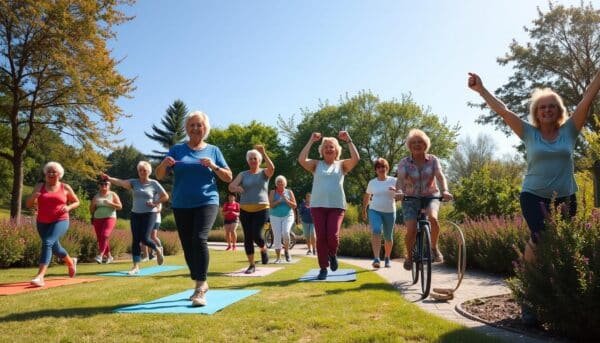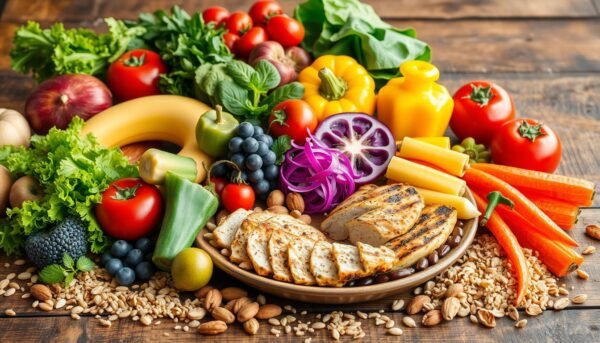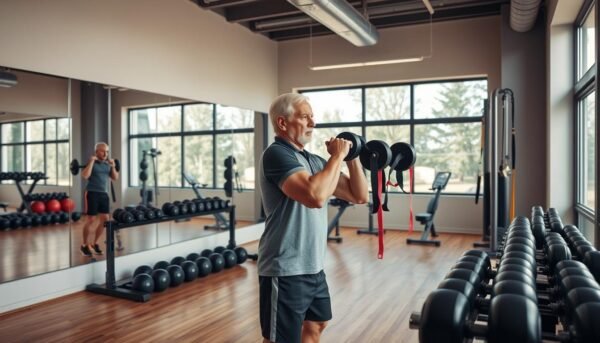As I turned 50, I noticed big changes in my body and energy. Keeping my weight down and staying active was hard. I wondered if losing 50 pounds was still possible.
Weight loss after 50 is tough, but not impossible. The right mindset and strategies can help. We’ll look into how to lose weight and feel young again.
It’s not easy, but you can still lose weight after 50. With the right plan, you can get healthier and feel great. Let’s find out how.
Understanding Weight Loss Challenges After 50

Weight loss gets harder as we get older, especially after 50. Hormonal changes, muscle loss, and stress play big roles. Knowing these challenges helps us find ways to stay healthy.
Hormonal Changes and Metabolism
Women over 50 often see estrogen levels drop. This can make insulin resistance worse and slow down metabolism. Also, not having enough thyroid hormone can cause weight gain and tiredness.
Impact of Muscle Mass Loss
We lose muscle as we age, a problem called sarcopenia. This makes it harder to lose weight because muscle burns more calories than fat. Losing muscle means our bodies burn fewer calories at rest.
Role of Stress and Cortisol
Stress is a big deal for weight control, especially for those over 50. High stress levels can make cortisol, a fat-storing hormone. To lose weight, managing stress is key. Mindfulness, meditation, and yoga can help.
Knowing the challenges of weight loss after 50 is the first step. By tackling hormonal issues, keeping muscle, and managing stress, we can achieve a healthy lifestyle and body transformation. This helps us reach our BMI goals.
The Science Behind Body Transformation at 50

As we get older, our bodies change in ways that affect weight loss. It’s key to know these changes to lose weight effectively after 50.
Women lose estrogen during menopause, leading to more belly fat and harder fat loss. This hormonal change also slows down metabolism. Plus, losing muscle mass with age makes it harder to burn calories.
To fight these changes, building muscle is crucial. Studies show that exercising can lower death risk by up to 17%. Keeping or gaining muscle helps burn fat and calories, aiding in weight loss.
Creating a lasting calorie deficit is also vital. It’s not true that carbs are bad for workouts and recovery. A balanced diet with carbs, protein, and fats is key. Listening to your body and tracking your BMI calculation helps tailor your weight management plan for better health.
| Transformation Success Stories | Key Insights |
|---|---|
| Jenn Reed lost 87 pounds while training to climb Mount Everest. | Focusing on building muscle mass, rather than just losing weight, is crucial for middle-aged women. |
| Patricia Jenkins lost 160 pounds, going from over 320 pounds to 160 pounds. | Embracing a balanced diet that includes carbohydrates, healthy fats, and proteins can fuel workouts and support recovery. |
| Chris Lindquist, at 58 years old, made a weight loss transformation and became a health coach. | Incorporating regular walking, including daily dog walks and treadmill usage, can be an effective and underrated activity for burning calories and supporting overall health. |
By grasping the science of body transformation, you can reach your weight loss goals after 50. This improves your health and well-being.
How to lose 50 pounds After Turning Fifty

Losing 50 pounds after fifty might seem hard. But, it’s doable with the right plan. You need a good diet plan and exercise routine for your age.
Creating a Sustainable Calorie Deficit
To lose weight, you must have a calorie deficit. Aim to lose 1-2 pounds a week. Cut 500-1000 calories from your daily food.
Eat more whole foods and less processed ones. Also, cut down on added sugars. Do both aerobic exercise and strength training to help lose weight.
Setting Realistic Weight Loss Goals
Setting realistic goals is key after 50. Don’t aim too high to avoid getting discouraged. Break big goals into smaller ones.
This makes it easier to stay motivated and celebrate your wins.
Tracking Progress Effectively
It’s important to track your progress. Use methods like weighing yourself and taking body measurements. Also, take progress photos.
This gives you a full view of your changes. It helps you stay on track with your healthy lifestyle.
Losing 50 pounds after 50 needs patience and a good plan. By managing your calorie deficit, setting smart goals, and tracking your progress, you can reach your goals. This will also boost your health and well-being.
Essential Exercise Strategies for Weight Management

Keeping a healthy weight after 50 can be tough. But, the right exercise can help you reach your goals. Mix aerobic exercise with resistance training for best results.
Try to do at least 150 minutes of moderate exercise each week. This can be brisk walking, swimming, or cycling. These activities burn up to 314 calories an hour, aiding in fat loss. For more impact, add high-intensity interval training (HIIT). It’s great for losing belly fat.
Don’t forget strength training. Do it two to three times a week. Exercises like bodyweight workouts, weight lifting, or using resistance bands build muscle. This is important for a high metabolism as you get older.
| Exercise Type | Recommended Frequency | Calorie Burn (for a 160-lb person) |
|---|---|---|
| Moderate Aerobic (e.g., brisk walking) | At least 150 minutes per week | 314 calories per hour |
| Vigorous Aerobic (e.g., running at 5 mph) | At least 75 minutes per week | 606 calories per hour |
| Strength Training | 2-3 sessions per week | N/A (builds muscle and boosts metabolism) |
Being consistent is crucial for exercise and body transformation. Begin slowly, aim for realistic goals, and celebrate your achievements. With commitment and the right exercises, you can manage your weight and stay healthy at any age.
Nutrition Guidelines for Successful Weight Loss

After 50, a balanced diet is key for lasting weight loss. The Mediterranean diet is a good choice. It includes whole grains, lean proteins, fruits, veggies, and healthy fats. This diet helps manage weight and boosts health.
Mediterranean Diet Benefits
The Mediterranean diet focuses on plants and olive oil for fat. It lowers heart disease and type 2 diabetes risk. It’s great for improving health and losing weight.
Portion Control Techniques
Portion control is vital for weight loss. Use smaller plates to eat less. Know the right serving sizes for each food group. Measure foods like nuts and oils to stay within calorie limits.
Meal Timing Strategies
Experiment with meal times to find what works for you. Some like intermittent fasting. Others eat big meals early to control blood sugar and cravings.
Choose whole foods over processed ones. Eat more fiber from veggies, fruits, and grains. This helps you feel full and keeps blood sugar stable. A good diet plan and healthy lifestyle are key.
| Nutrition Guideline | Recommendation |
|---|---|
| Total Fiber Intake | 25 to 30 grams daily |
| Moderate-Intensity Physical Activity | 150 minutes weekly |
| Servings of Vegetables and Fruits | 4 and 3 servings per day, respectively |
| Calorie Deficit for Weight Loss | 500 to 750 calories less than intake per day |
| Weight Loss Goal | 1 to 2 pounds (0.5 to 1 kilogram) per week |
Use these portion control and diet plan tips to help with weight loss. They support a healthy lifestyle after 50.
Building and Maintaining Muscle Mass

As we get older, keeping and growing muscle is key for our health. After 50, we lose muscle at 3% to 5% each decade. This can hurt our strength, balance, and how we move. But, with the right workout and healthy living, we can fight this loss and change our bodies for the better.
To grow and keep muscle, mix resistance training with good food. Do strength exercises for all big muscle groups two to three times a week. Use free weights, machines, and bodyweight exercises. As you get stronger, add more weight and reps to challenge your muscles.
Also, eat enough protein to help muscles grow and fix themselves. Aim for 1.2 to 1.6 grams of protein for every kilogram of your weight each day. This helps your body build and keep lean muscle, which is vital for a good body transformation and healthy lifestyle.
Don’t forget, rest and recovery are crucial for muscle growth. Give your muscles time to heal between workouts. This is when they fix and grow. Sleep well, aiming for 7 to 9 hours a night, to help your body build muscle naturally.
With a balanced exercise routine, enough protein, and rest, you can keep and grow muscle as you age. This supports your body transformation and leads to a healthier, more lively lifestyle.
The Role of Sleep and Recovery in Weight Loss

Getting quality sleep is key for losing weight, especially as we age. Try to sleep 7-9 hours each night. This helps you stay on track with your healthy lifestyle, body transformation, and weight loss goals.
Optimal Sleep Duration
Research finds that adults sleeping less than seven hours a night tend to weigh more. Men over 50 should aim for 7-9 hours of sleep. Sleeping too little or too much can lead to weight gain.
Managing Sleep Disruptions
As we age, sleep can be disrupted by hot flashes, night sweats, and insomnia. To improve sleep, create a calming bedtime routine and make your sleep space comfortable. Cognitive behavioral therapy can also help with ongoing sleep issues.
Resting well between workouts is as crucial as the workout itself. It helps prevent burnout and supports your health and weight loss goals. By valuing sleep, you’ll find it easier to handle the challenges of a healthy lifestyle after 50.
| Sleep Duration | Potential Impact on Weight |
|---|---|
| Less than 7 hours per night | Increased risk of obesity and higher BMI |
| 7-9 hours per night | Optimal range for weight loss and maintenance |
| More than 9 hours per night | Increased risk of weight gain |
Managing Stress for Effective Weight Loss
Starting my healthy lifestyle and weight loss journey after 50, I found managing stress is key. Chronic stress can harm my body, making it harder to lose weight, especially around my belly. Adding stress-reducing activities to my routine helps my body lose weight naturally.
Mindfulness practices like meditation, yoga, and deep breathing are very helpful. They relax my body and clear my mind, helping me focus on losing weight. Journaling and talking to a therapist also help me deal with emotional stress.
Eating a balanced diet full of fruits, veggies, lean proteins, and whole grains is important for me. Drinking lots of water and getting enough sleep are also crucial. By taking care of myself and setting realistic goals, I handle my weight loss journey better.
This post may contain affiliate links which means I may receive a commission for purchases made through links. I will only recommend products that I have personally used! Learn more on my Private Policy page.